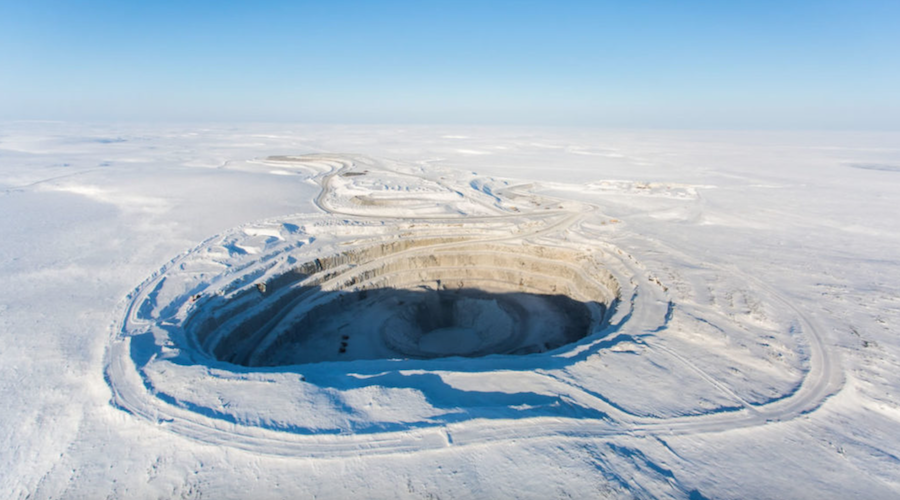Floating drillrig
Diamond fields in Canada are typically characterized by two factors, which require the application of unconventional mining methods.
The first factor is that about 75% of the diamond pipes in Canada are situated beneath a lake. This makes open pit mining difficult or impossible, as well as complicating the use of the other conventional approach–mining underground beneath the lake bed.
The second factor is that a considerable number of Canadian diamond pipes have small cross-sections (up to 4-5 hectares). This increases the capital investment, and consequently reduces profitability.
In this regard, heed should be paid to the unconventional method used by De Beers for the diamond mining at the African shelf. A ship equipped with a special unit is used as a floating drillrig, which collects bottom deposits and delivers them to the ship as muck. Diamonds are recovered from the muck by a concentrating mini-mill located onboard the ship. The principle of operation of this type of unit is the same as conventional pneumatic suction drillrigs, except for the special drillbit, which does not cut into rock, but instead loosens bottom deposits and rakes them up to the suction hole of a drill string.
This method is the lowest cost diamond mining method in the world. It would seem to be particularly effective for the conditions of Canada as it is swiftly deployable, has low capital costs, minimal adverse environmental impact, eliminates unsafe underground working conditions and is cost-effective.
By the same token, one can imagine a drillrig afloat the lake above the diamondiferous pipe, similar to the one described above and equipped with a special diamond mining drill to drill out the diamondiferous ore efficiently. Similar to drilling from solid land, shaft wall failure is avoided by the static pressure of liquid (water, in the simplest case) that compensates for the pressure in the rocks surrounding the orebody.
The drilling mining technology is relatively simple even when there is no natural basin over the pipe. Under these conditions a 2-3-m-deep artificial basin can be made over the pipe before drilling starts.
An essential advantage of such drilling technology is reducing impact on the environment. This technology eliminates both open-pit mining and draining of underground water into land basins and grounds, thus reducing the footprint, and significantly decreasing diesel engine emissions into the atmosphere.
Experimental drillrig models
A floating unit with the required specifications could be assembled by placing a drillrig such as L-35 or L-40 (manufactured by WIRTH Maschinen- und Bohrgerate- Fabrik GmbH) onto pontoons. The drill has to be able to provide maximal drilling performance with minimal damage to diamonds. In principle, these requirements are met by a “benching drill” design.
Such a drill (see photo) passed testing as a component of a L-35 drillrig and was later deployed for drilling shaft wells in the coal basin at Donetsk, Ukraine, in 1989-1995. The total length of holes with 3.2- to 4.8-m diameter, drilled in different mining and geological conditions, was about 3,000 m.
The most distinctive feature of the benching drill is its multilevel step design. This feature gives it several advantages compared with conventional flat-shape designs.
* Destruction of rock by large chipping is ensured by the continuous forming of stair-like concentric surfaces in the orebody. Large chunks of ore are broken off by wedge-shaped disk cutters. Stair-like cutting surfaces are not formed with conventional (“frontal impact”) rock destruction by a toothed cutter.
For average ‘banana’-size cutting, which is typical for benching rock boring, the drill speed is two or three times as much as for ‘sand’-size cutting, typical for frontal rock boring. The electric power consumption is approximately 1.5 times lower, and that of a rolling cutter drill tool is approximately three times lower compared with the conventional drilling method.
All factors combined (i.e., drilling speed, electric power consumption and bit tool consumption), the efficiency of benching drilling is five to eight times better than that of conventional drilling with a flat working face. The benching drilling cost may be estimated tentatively as five to six times less than with flat face drilling.
* Full drilling fluid flow pumped by an airlift is concentrated on the small area of the lower flat part of the working face under the picker, which makes up 1-2% of the drillable borehole area. This makes practically instantaneous disposal of broken muck possible from under the sinker, where the muck is coming from the benching part of the tool. It also practically excludes rock milling there, and reduces to a minimum the probability of crushing diamonds. The high drilling fluid concentration also precludes the formation of a “shale collar” (clay particle clusters), which is typical for flat-shaped drill tools, and sharply reduces the drill rate while drilling with such bits.
* Maximum preservation of diamonds is achieved while crushing rock using the benching method, while the bulk of rock is destroyed. Diamond safeguarding is possible because a sufficiently sharp disk rolling cutter (self-sharpening occurs while the cutter is operating) affects the rock mass only along the line of the bench perimeter, whereas its width is not affected. In this regard, the probability of the tool and a diamond meeting on the circular platform of a separate bench is very small. It is also true for the sum of all bench areas, which make up as much as 98-99% of borehole area, whereas when “frontal” rock destruction is performed by a conventional flat-drill bit, toothed cutters work up every ring sector of the working face, so that the teeth strike the rock one at a time. Therefore the probability of a tooth hitting a diamond increases dramatically.
Diamond mining efficiency depends on the structural and strength properties of a given mine block. With average rock strength of about 50 MPa, and engineering capabilities of transmission of the rotary table of an L-40 unit and benching drill diameter of 8 m, it may be predicted with sufficient certainty that diamond mining productivity would be some 200,000-250,000 tonnes per single drill rig annually. The number of simultaneous working units can be determined only by the shape of each pipe. Existing drillrigs are capable of achieving a mining depth of up to 1,000 m if they are completed with benching drills, and up to 1,500 m or more when those drills are specially designed.
As to the costs pertaining to drilling by means of benching drills, they can be roughly estimated based on the fact that costs of electrical power consumption constitute approximately one third of total costs while drilling, and the total electric power of a drilling rig is 800 kVA. Assuming that the mechanical drill speed for a mining drill is 0.6 m/h, diameter of drilling is 6.5 m, diamondiferous rock density is 2 t/m3 and all current collectors operate with maximum loading while drilling, the total costs per tonne of kimberlite, expressed in terms of electrical power consumption, will be about 60 kWh. The actual cost per unit is therefore determined by the electric power price in a given region.
The authors already have experience in drill-mining of kimberlite gained during geologic exploration of diamond deposits in the Arkhangelsk Oblast of Russia. The L-35 drillrig was placed on pontoons because of ground bogging. The main principles of this technology have been essentially proven. As a drilling device a conventional (frontal impact) bit with a 4-m diameter was used. The performance of the process was not very good, due to the technical drawbacks of conventional technology.
Dr. I. Kouptchinski is a mining engineer. He is head of a laboratory for large-diameter vertical boring at the National Science Academy of Ukraine, 54 Tsygarevsky Drive, Kharkov, 61010 Ukraine. Dr.
V. Kouptchinski is an electrical engineer. He works as a systems engineer at the University of Toronto, 4 Bancroft Ave., Toronto ON M5S 1C1, e-mail: v.kupchinsky@utoronto.ca.





Comments